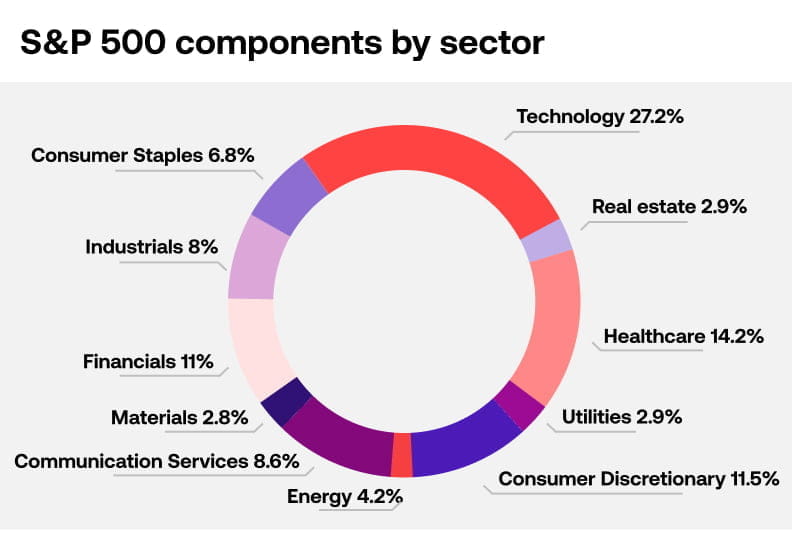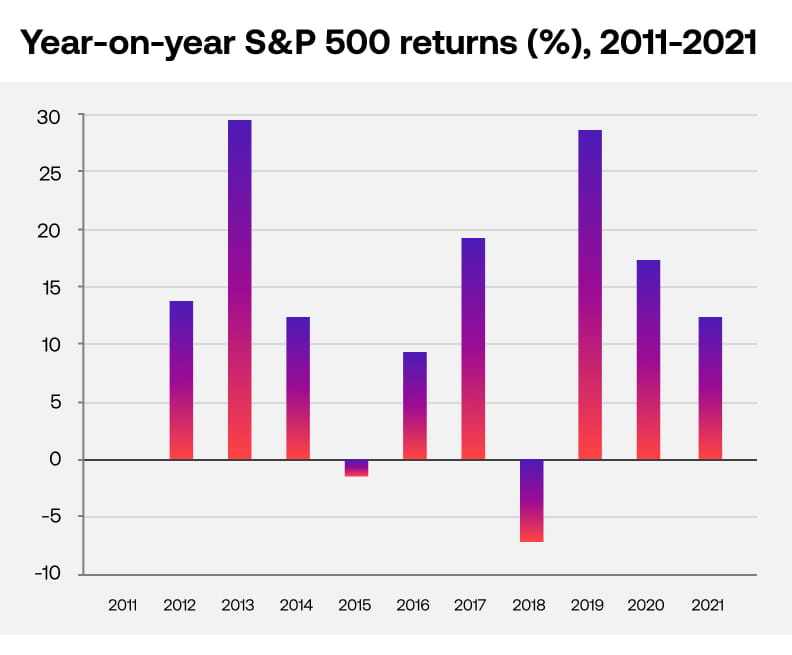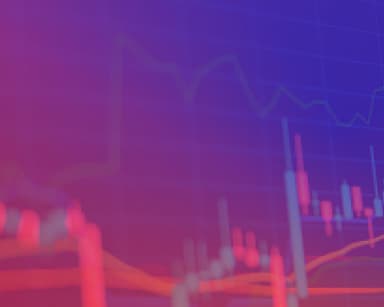- What is the S&P 500 index?
- S&P 500 companies
- How to trade the S&P 500
- S&P 500 opening hours
- How is the S&P 500 calculated?
- What moves the S&P's price?
- S&P 500 average returns
- S&P 500 companies list
- S&P 500 FAQ
What is the S&P 500 index?
The S&P 500 is a benchmark stock index comprising of around 500 of the largest companies listed in the United States by market cap. It is seen as one of the most important stock indices in the world; a key measure of both the US and global economy.
On the City Index platform, the S&P is called the US SP 500.
Created in 1957 with a value of 386.36, the S&P 500 originally tracked 500 large corporations listed on the New York Stock Exchange. Today, it also includes businesses on the NASDAQ.
S&P 500 companies
The S&P 500 covers 500 of the biggest public companies in the United States, unlike:
- The Dow Jones, which only includes 30 companies handpicked by a committee
- The Nasdaq 100, which doesn't include financial companies or any businesses on the New York Stock Exchange
So as well as including technology giants like Apple, Alphabet, Amazon, Microsoft and Meta, the S&P is home to Berkshire Hathaway, Burger King, Walmart, Goldman Sachs and more. Tesla is a more recent addition to index, joining in December 2020.
Here’s how the S&P sector composition looked as of May 26 2022.

Take a look at the top ten company listed on the S&P 500 in 2022.
What are the listing criteria for the S&P 500?
Not every company with a large enough market cap is added to the S&P index – they have to meet strict criteria. As well as market cap, the listing criteria also take into account factors such as organisational structure, share type and liquidity, and the proportion of shares available to the public.
Plus, unlike some other indices, a company’s most recent quarterly earnings – as well as the sum of its last four consecutive quarters’ earnings – must be positive. That stipulation has proven controversial in the past. It meant, for example, that Google didn’t join the S&P until 2006.
There is also an element of discretion to the inclusion of a given company. Tesla was originally overlooked for entry by the S&P 500’s index committee, with some suggesting that its extreme volatility may have raised potential reputational concerns for the index.
How often do S&P 500 companies change?
S&P 500 company eligibility is under periodical review by the index committee with updates occurring when required, normally within a few days’ notice. As the weighting percentage naturally can be expected to change for all companies, a rebalancing is undertaken four times a year.
How to trade the S&P 500
Let’s cover four popular ways to trade the S&P 500 index in the UK: CFDs, spread betting, futures and ETFs. The first three are all derivatives – financial instruments that ‘derive’ their price from other assets. ETFs, meanwhile, are funds that many people use to invest in the S&P.
S&P 500 CFDs
S&P CFDs are instruments that track the price of the S&P 500 index. If you think the index is headed up, you can buy CFDs. Then, if it rises, you can sell your CFDs back to your provider in return for a profit. If it falls, you’ll make a loss.
Alternatively, you can sell CFDs to open a short trade.
Learn more about CFDs.
S&P spread betting
With spread betting, you are betting a set number of pounds per point on where the S&P is headed next.
As it heads in your chosen direction, you make a profit. If it moves the other way, you make a loss.
Learn more about spread betting.
S&P 500 futures
With S&P futures, you agree to buy or sell the index at a set price on a set upcoming date.
Your profit or loss is determined by how far the S&P’s price is from the price of your future when the contract expires.
Learn more about futures trading.
S&P 500 ETFs
ETFs are funds that contain all the stocks present on an index. In this case, the S&P 500.
Unlike other funds, ETFs are traded on exchanges, just like shares. Hence the name: exchange traded funds.
Learn more about trading ETFs.
Read more about how to trade indices here.
S&P opening hours
All US stock indices share the same hours:
| Pre-market | Standard trading | After-hours | |
|---|---|---|---|
| Local time | 04:00 – 09:30 | 09:30 – 16:00 | 16:00 – 20:00 |
| UTC | 08:00 – 13:30 | 13:30 – 20:00 | 20:00 – 00:00 |
With your City Index account, you can access the index 24 hours a day Monday to Friday.
Learn more about stock market hours
How is the S&P calculated?
The S&P 500 is calculated using a free-float methodology, weighting each constituent based on their market cap. This calculation disregards those shares that cannot be traded, such as government-owned shares.To calculate the precise weighting for each company, S&P divides their market capitalisation by the total capitalisation of the index. For example, if Apple’s market cap is $2 trillion and the total market cap of the S&P 500 is $30 trillion, this would equate to around a 6.6% weighting for the constituent company.
What moves the S&P's price?
With 500 constituents, numerous factors could be the cause for the S&P 500’s movements on a given day. However, there are a few things you should watch out for:
1. Fundamental data
As the leading US index, the S&P 500’s performance is closely tied to the overall performance of the US stock market. When US companies are doing well, it will rise. When US companies are struggling, it tends to fall.
There are countless reasons why US business might be on the rise or not. However, a few important fundamentals to follow are:
- Interest rates. Low interest rates are usually good for corporations. They can borrow money easily to fund growth, consumers are encouraged to spend instead of saving, and investors are encouraged to focus on stocks instead of other assets like bonds
- Inflation. High inflation can erode profit margins, and is often followed by an interest-rate hike to rein in the economy. So when inflation looks like it is swelling, investors may look to sell their stocks – causing the S&P to fall
- Employment. Higher employment means more people are earning money, which means more people are spending money. This is good for businesses. However, high employment may also lead to tighter monetary policy, which means higher rates and a falling S&P 500
2. Individual companies
When we talk about ‘weighting’ constituents, it means determining how much their price movements will impact the overall index.
With around 500 constituents to track, a single company is less likely to cause a major swing on the S&P 500 than other benchmarks. Apple’s weighting on the index is around 6%, for example, compared to 11% on the Nasdaq 100.
However, 6% is still a high proportion for a single stock. And between them, the FAAMG stocks of Meta, Apple, Amazon, Microsoft and Google are responsible for around a fifth of the index’s movements any given day.
3. Market crashes
Sometimes, events beyond companies’ control can cause widespread investor fear and provoke huge market selloffs.
One of the most famous examples of this was ‘Black Monday’ in 1987, when the S&P 500 lost 20% of its total value in single day. Few saw the crash coming.
Sometimes, ‘corrections’ occur after mass buying has sent stocks too high. After sustained bull runs, you’ll often see analysts predict that a correction is just around the corner. Trying to trade crashes, though, is a tricky strategy – the markets can remain irrational for long periods.
S&P 500 average returns
The S&P 500 has returned 12.1% on average each year over the past ten years. That means that if you’d invested in the S&P back in 2011, you’d make 12.1% back each year on average.
The chart below shows you how much the S&P has returned each year since 2011. As you can see, the variation between years is strong. The index grew by almost 30% in 2013 and 2019 – but didn’t grow at all in 2015 and 2018.

S&P 500 companies list
The below chart shows the top ten companies in the S&P 500, correct as of May 2022. At the point captured, the top ten alone made up 27.2% of the weighting for the entire index, illustrating the influence these companies can have on the whole benchmark.| Rank | Ticker | Company name | Weighting |
|---|---|---|---|
| 1 | AAPL | Apple | 6.8% |
| 2 | MSFT | Microsoft | 5.9% |
| 3 | AMZN | Amazon | 2.8% |
| 4 | GOOGL | Alphabet (Class A shares) | 2.1% |
| 5 | GOOG | Alphabet (Class C shares) | 1.9% |
| 6 | TSLA | Tesla | 1.8% |
| 7 | BRK.B | Berkshire Hathaway | 1.7% |
| 8 | JNJ | Johnson & Johnson | 1.4% |
| 9 | UNH | UnitedHealth Group Incorporated | 1.4% |
| 10 | FB | Meta Platforms | 1.3% |



